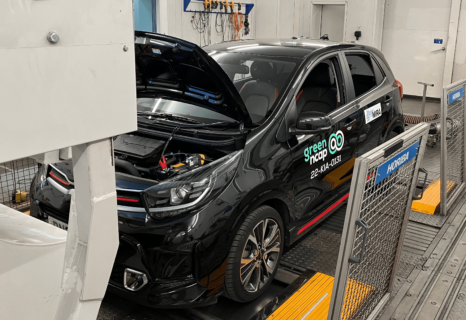Kia Picanto GT-line petrol FWD manual
2023
51%
5.3
10
Clean Air Index
5.7
10
Energy Efficiency Index
4.3
10
Greenhouse Gas Index
| Laboratory Tests | NMHC | NOX | NH3 | CO | PN | |
|---|---|---|---|---|---|---|
| 6.110 | Cold Test | |||||
| 7.110 | Warm Test | |||||
| 2.910 | Highway | |||||
| 4.610 | Cold Ambient Test | |||||
| Road Test | ||||||
| 6.410 | On-Road Drive | |||||
| 2.05 | On-Road Short Trip | |||||
| 2.98 | On-Road Heavy Load | |||||
| 3.75 | On-Road Light Load | |||||
| 2.02 | Congestion | |||||
| Laboratory Tests | Energy | |||
|---|---|---|---|---|
| 6.110 | Cold Test | |||
| 6.310 | Warm Test | |||
| 4.810 | Highway | |||
| 5.510 | Cold Ambient Test | |||
| Consumption | Driving Range | |||
| Average | 5.8l100 km | 614km | ||
| Worst-Case | 8.0l100 km | 436km | ||
| Greenhouse Gases | CO2 | N2O | CH4 | |
|---|---|---|---|---|
| 4.910 | Cold Test | |||
| 5.210 | Warm Test | |||
| 3.310 | Highway | |||
| 4.110 | Cold Ambient Test |
Specifications
- Tested Car KNAB3519LNT93XXXX
- Publication Date 02 2023
- Vehicle Class City and Supermini
- Emissions Class Euro 6 AP
- Tyres 195/45R16 84V
- Mass 1,019 kg
- Engine Size 998 cc
- Power/Torque 73.6 kW/172 Nm
- Declared CO2 119 g/km
- Declared Consumption 5.3 l/100 km








































































































































Our verdict
Update April 2023: The torque value in the technical specifications has been corrected. The vehicle is equipped with a gasoline particle filter. The rating results remain unchanged.
Tested here is the 2022 model Kia Picanto GT-line 1.0 l petrol with a 5-speed manual transmission. This is a compact hatchback targeting consumers who require a small, fuel-efficient low-cost car capable of easily navigating around towns and cities. The 1.0 l gasoline engine is a suitable choice for this purpose, providing good fuel consumption values in a variety of driving conditions. Despite this, the fuel consumption performance could be further improved to further lower the CO2 output and improve the Greenhouse Gas Index results. The exhaust aftertreatment shows average performance with a general weakness in particle control and threshold-exceeding CO emissions in the high power demanding Highway Test. The gasoline particle filter should manage better in controlling particle number emissions during cold start, high load, and cold ambient conditions. Overall, the Kia Picanto GT-line 1.0 l performed well enough to warrant further robustness testing, and achieved an overall rating of 3 Green Stars and a Weighted Overall Index of 5.1 out of 10.